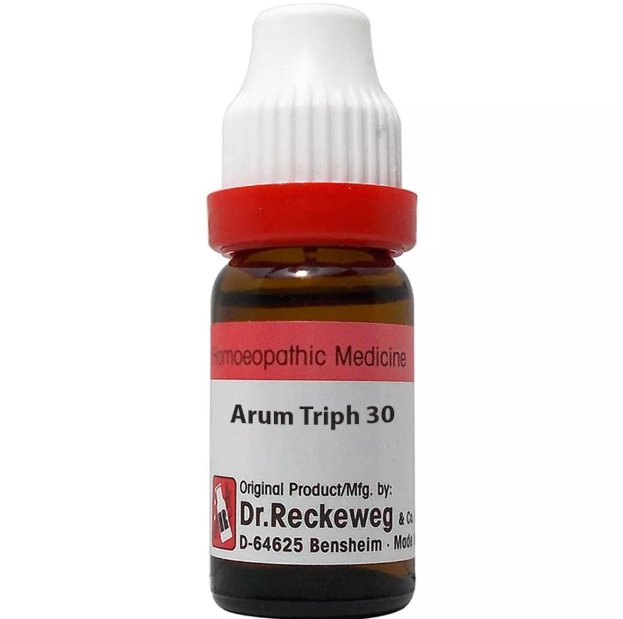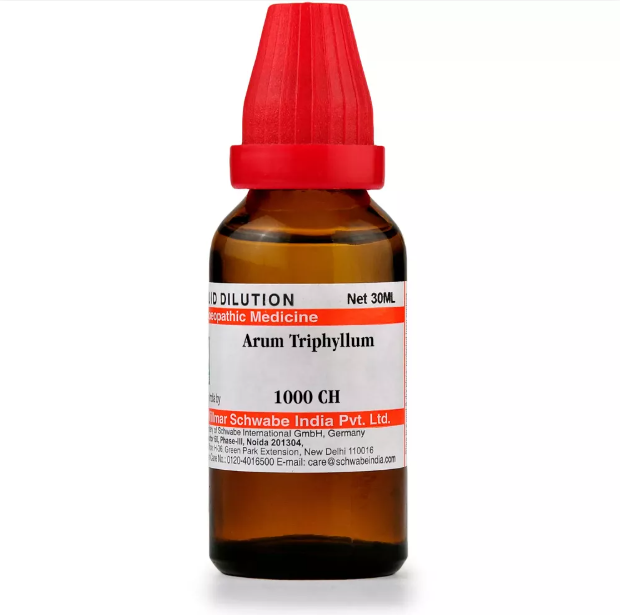ARUM TRIPHYLLUM Q, 6C, 12C, 30C, 200C, 1M, 10M USES AND SYMPTOMS
 Arum Triphyllum, commonly known as Jack in the Pulpit, shares its medicinal properties with Arum maculatum and Arum dracontium. They all contain an irritating toxin that inflames mucous surfaces and damages tissues. The hallmark of Arum Triphyllum is its acrid nature.
Arum Triphyllum, commonly known as Jack in the Pulpit, shares its medicinal properties with Arum maculatum and Arum dracontium. They all contain an irritating toxin that inflames mucous surfaces and damages tissues. The hallmark of Arum Triphyllum is its acrid nature.
Head: Intense headache, feels like boring into the pillow (reminiscent of meningitis). Headache exacerbated by overheating and hot beverages like coffee.
Eyes: Twitching of upper eyelids, particularly on the left side.
Nose: Nostrils sore and tender. Discharges from the nose are acrid, causing raw sores. Nasal passages obstructed, forcing breathing through the mouth. Sensation of boring pain within the nose. Coryza with watery discharge streaked with blood. Hay fever with nose root pain. Formation of large scabs, mainly on the right side of the nose. Persistent picking of the nose until bleeding occurs.
Mouth: Roof and palate feel raw. Lips and soft palate tender and burning. Lips become chapped and painful. Corners of the mouth crack and sore. Tongue appears red and sore; entire oral cavity feels raw. Compulsive lip-picking leading to bleeding. Saliva production increases, with an acrid and corrosive quality.
Throat: Swelling of sub-maxillary glands. Throat feels constricted, swollen, burning, and raw. Frequent clearing of the throat. Hoarseness and excessive mucus expectoration. Sensation of soreness in the lungs. Symptoms akin to clergyman’s sore throat. Voice becomes uncertain and uncontrollable, worsened by speaking or singing. Effective in cases of diphtheria.
Skin: Development of a scarlet rash and raw, bloody surfaces. Effective in impetigo contagiosa cases.
Modality: Symptoms worsen with northwest winds and when lying down.
Relationships: Comparable to Ammonium carbonicum, Ailanthus, and Allium cepa.
Antidotes: Buttermilk; Aceticum acidum, Pulsatilla.
Dosage: Administer in potencies ranging from third to thirtieth.
SYMPTOMS OF ARUM TRIPHYLLUM
Head Symptoms:
Intense headache, akin to feeling the head boring into the pillow (reminiscent of meningitis).
Headache aggravated by overheating and consumption of hot beverages like coffee.
Eye Symptoms:
Twitching of the upper eyelids, particularly noticeable on the left side.
Nose Symptoms:
Soreness and tenderness in the nostrils.
Nasal discharges are acrid, causing raw sores.
Obstruction of nasal passages, necessitating mouth breathing.
Sensation of boring pain within the nose.
Coryza with watery discharge streaked with blood.
Hay fever accompanied by pain at the root of the nose.
Formation of large scabs, mainly on the right side of the nose.
Persistent picking of the nose leading to bleeding.
Mouth Symptoms:
Raw feeling in the roof and palate of the mouth.
Lips and soft palate are tender and burning.
Lips become chapped and painful.
Corners of the mouth crack and are sore.
Tongue appears red and sore; entire oral cavity feels raw.
Compulsive lip-picking leading to bleeding.
Increased saliva production, which is acrid and corrosive.
Throat Symptoms:
Swelling of sub-maxillary glands.
Throat feels constricted, swollen, burning, and raw.
Frequent clearing of the throat.
Hoarseness and excessive mucus expectoration.
Sensation of soreness in the lungs.
Symptoms akin to clergyman’s sore throat.
Voice becomes uncertain and uncontrollable, worsened by speaking or singing.
Effective in cases of diphtheria.
Skin Symptoms:
Development of a scarlet rash and raw, bloody surfaces.
Effective in cases of impetigo contagiosa.
Modality:
Symptoms worsen with northwest winds and when lying down.
Relationships:
Comparable to Ammonium carbonicum, Ailanthus, and Allium cepa.
Antidotes:
Buttermilk; Aceticum acidum, Pulsatilla.
Dosage:
Administer in potencies ranging from third to thirtieth.
selection of the potency
Individualization:
- Homeopathy is based on the principle of treating the individual, not just the disease. The unique symptoms and characteristics of the person are crucial in determining the most suitable potency.
Intensity of Symptoms:
- The intensity of the symptoms guides the choice of potency. If the symptoms are intense and acute, a lower potency (e.g., 6C, 30C) might be considered. For chronic conditions with less intensity, higher potencies (e.g., 200C, 1M) may be appropriate.
Sensitivity of the Patient:
- Some individuals are more sensitive to homeopathic remedies, while others may require higher potencies. The practitioner considers the patient’s sensitivity when selecting the potency.
Acute vs. Chronic Conditions:
- Lower potencies are often used for acute conditions, while higher potencies may be considered for chronic or long-standing issues.
Previous Response to Potencies:
- The patient’s response to previous homeopathic treatments helps guide the choice of potency. If a particular potency has been effective in the past, it may be repeated or adjusted as needed.
Vital Force and Susceptibility:
- Homeopathy views illness as a disturbance in the vital force. The practitioner assesses the patient’s overall vitality and susceptibility to determine the appropriate potency.
Aggravation or Amelioration:
- The direction of the symptom response (aggravation or amelioration) after taking a remedy can influence the choice of potency.
Miasmatic Considerations:
- In classical homeopathy, the concept of miasms (inherited disease tendencies) is considered. The practitioner take this into account when selecting the potency.
Practitioner Experience:
- The experience and preference of the homeopathic practitioner play a role. Some practitioners may have success with certain potencies based on their clinical experience.
SAFETY INFORMATION
- Do not exceed the recommended dose by physician
- Keep out of the reach of children
- Store in a cool dry place away from direct sunlight
- Maintain half an hour gap between food/drink/any other medicines and homoeopathic medicine
- Avoid any strong smell in the mouth while taking medicine e.g. camphor, garlic, onion, coffee, hing
Medicine images use for reference only selection of homeopathic medicine depends on the individual’s specific symptoms and overall constitution. Moreover, homeopathy is a holistic system of medicine that treats the individual as a whole. In addition to addressing the physical symptoms, it takes into account the emotional and mental state of the person. Consequently, it’s crucial to consult with a qualified homeopathic practitioner for personalized treatment.
The information provided on this website is intended solely for educational purposes. Always seek the advice of your physician or other qualified health provider.
